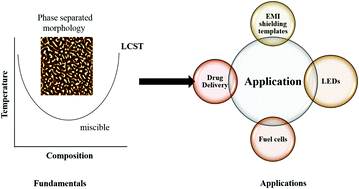Nanoparticles influence miscibility in LCST polymer blends: from fundamental perspective to current applications
Abstract
Polymer blending is an effective method that can be used to fabricate new versatile materials with enhanced properties. The blending of two polymers can result in either a miscible or an immiscible polymer blend system. This present review provides an in-depth summary of the miscibility of LCST polymer blend systems, an area that has garnered much attention in the past few years. The initial discourse of the present review mainly focuses on process-induced changes in the miscibility of polymer blend systems, and how the preparation of polymer blends affects their final properties. This review further highlights how nanoparticles induce miscibility and describes the various methods that can be implemented to avoid nanoparticle aggregation. The concepts and different state-of-the-art experimental methods which can be used to determine miscibility in polymer blends are also highlighted. Lastly, the importance of studying miscible polymer blends is extensively explored by looking at their importance in barrier materials, EMI shielding, corrosion protection, light-emitting diodes, gas separation, and lithium battery applications. The primary goal of this review is to cover the journey from the fundamental aspects of miscible polymer blends to their applications.

- This article is part of the themed collections: PCCP Perspectives and 2020 PCCP HOT Articles


 Please wait while we load your content...
Please wait while we load your content...